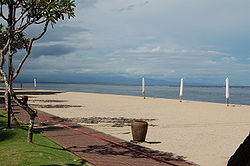Bali's Day of Silence (March 31, 2014)
Nyepi is a Balinese "Day of Silence" that is commemorated every Isakawarsa (Saka new year) according to the Balinese calendar (in 2014, it falls on March 31). It is a Hindu celebration mainly celebrated in Bali, Indonesia. Nyepi, a public holiday in Indonesia, is a day of silence, fasting and meditation for the Balinese. The day following Nyepi is also celebrated as New Year's Day.[1][2] The same day celebrated in India as ugadi.
Observed from 6 a.m. until 6 a.m. the next morning, Nyepi is a day reserved for self-reflection, and as such, anything that might interfere with that purpose is restricted. The main restrictions are no lighting fires (and lights must be kept low); no working; no entertainment or pleasure; no traveling; and, for some, no talking or eating at all. The effect of these prohibitions is that Bali's usually bustling streets and roads are empty, there is little or no noise from TVs and radios, and few signs of activity are seen even inside homes. The only people to be seen outdoors are the Pecalang, traditional security men who patrol the streets to ensure the prohibitions are being followed.
Although Nyepi is primarily a Hindu holiday, non-Hindu residents of Bali observe the day of silence as well, out of respect for their fellow citizens. Even tourists are not exempt; although free to do as they wish inside their hotels, no one is allowed onto the beaches or streets, and the only airport in Bali remains closed for the entire day. The only exceptions granted are for emergency vehicles carrying those with life-threatening conditions and women about to give birth.
On the day after Nyepi, known as Ngembak Geni, social activity picks up again quickly, as families and friends gather to ask forgiveness from one another, and to perform certain religious rituals together.
---------------------------------------------------------------------------------------------
Hari Raya Nyepi is the New Year for Balinese Hindus celebrating the Caka Year of 1936. On this very auspicious occasion, many ceremonies and rituals are held throughout the Island of Bali, we have detailed below the events taking place this period and would like you to respect the local culture.
Saturday, 29 March 2014
One of the most important preparations for the coming New Year is the Purification Ceremony, known locally as “Melasti”, held on Saturday, 29th March. Offering and holy objects such as statues and “keris” line the path of the colourful procession leading to the beach for ritual cleansing. Flowers fill the beach and prayers fill the air as pilgrims cleanse themselves in the sea. You are requested to witness this ceremony with decorum, from a distance.
Sunday, 30 March 2014
The climax of ritual activity is on the eve of Nyepi, the darkest night of the new moon. During these solemn, powerful hours, priests throughout Bali will perform a Tawur agung, praying and ritually sacrificing a variety of animals to appease the demons and honor the gods is an attempt to harmonize the conflicting universal powers of good and evil.
Ogoh Ogoh (Paper Mache) Statue Burning.
Join us for a rather special Balinese event.
Help us carry our Ogoh Ogoh (paper Mache statue) around the hotel to scare away the bad spirits. We’ll provide you with a special Balinese Arak drink and a Balinese Headband and Sarong. We will end the procession on the beach and burn the Ogoh Ogoh on the Beach
Monday, 31 March 2014
Monday, 31 March 2014
The first day of the Caka New Year, also known as Hari Raya Nyepi, is a Day of Complete Silence in Bali. The whole island will be void of people on the streets (since it is mandatory for everyone to stay indoors) or on the hotel premises and there shall be no noise, no lights and no activities in whatsoever form. The whole island of Bali shall appear deserted and therefore it is believed that the evil spirits will pass over the island.
---------------------------------------------------------------------------------------------------------
.jpg)
.jpg)

------------------------------------------------------------------------------------------------------
- First, The Melasti Ritual is performed 3–4 days beforehand. It is dedicated to Sanghyang Widhi Wasa. The ritual is performed in Pura (Balinese temple) near the sea (Pura Segara) and meant to purify Arca, Pratima, and Pralingga (sacred objects) belonging to several temples, also to acquire sacred water from the sea.
- Second, The Bhuta Yajna Ritual is performed in order to vanquish the negative elements and create a balance with God, Mankind, and Nature. The ritual is also meant to appease Batara Kala byPecaruan offering. Devout Hindu Balinese villages usually make ogoh-ogoh, demonic statues made of bamboo and paper symbolizing negative elements or malevolent spirits. After the ogoh-ogoh have been paraded around the village, the Ngrupuk ritual takes place, which involves burning the ogoh-ogoh.
- Third, the Nyepi Rituals are performed as follows:
- Amati Geni: No fire or light, including no electricity
- Amati Karya: No working
- Amati Lelunganan: No travelling
- Amati Lelanguan: Fasting and no revelry/self-entertainment
- Fourth, the Yoga/Brata Ritual starts at 6:00 a.m. and continues to 6:00 p.m. the next day.
- Fifth, the Ngembak Agni/Labuh Brata Ritual is performed for all Hindus to forgive each other and to welcome the new days to come.
- Sixth and finally, The Dharma Shanti Rituals is performed after all the Nyepi rituals finished.[5]
| Balinese Year | CE Year | Date |
|---|---|---|
| 1931 | 2009 | 26 March |
| 1932 | 2010 | 16 March |
| 1933 | 2011 | 5 March |
| 1934 | 2012 | 23 March |
| 1935 | 2013 | 12 March |
| 1936 | 2014 | 31 March |
.jpg)
.jpg)
.jpg)
.jpg)

.jpg)
.jpg)



Tidak ada komentar:
Posting Komentar